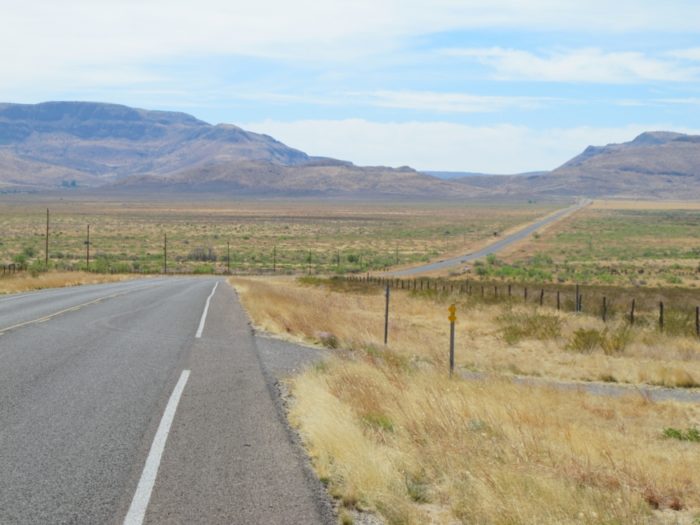
Image Credit: Alex Wilson
Image Credit: Alex Wilson My route took me along the Mexican border in places; here's the infamous border fence in California.
Image Credit: Alex Wilson The Hassayampa River Nature Conservancy Preserve in Arizona — green in the desert.
Image Credit: Alex Wilson Camping at 6,000 feet in the Big Lue Mountains of Eastern Arizona as I threaded my way through the Rockies.
Image Credit: Alex Wilson Trying to avoid predicted wind, I got an early start out of Kingston, New Mexico, and had pedaled 20 miles by sunrise.
Image Credit: Alex Wilson In Hatch, New Mexico, the wind was so strong that it literally blew me into the road several times.
Image Credit: Alex Wilson John Kuehne in front of one of the large telescopes at the McDonald Observatory.
Image Credit: Alex Wilson East of Fort Davis, Texas, I rode past miles and miles of burned-over land from wildfires a few days earlier; here a pronghorn antelope paws in the dust.
Image Credit: Alex Wilson The highway I rode on through El Paso was one of the low points — an endless strip of gas stations and fast-food restaurants.
Image Credit: Alex Wilson Growing cotton in the Imperial Valley of California takes a lot of water, all of it from the Colorado River and delivered via flood-irrigation. This in an area getting 8 inches of rain annually. Passing such scenes made me think about this precious resource.
Image Credit: Alex Wilson
Back in March I reported that I would be taking leave from this blog as I embarked on an eight-month sabbatical. With support from the Hanley Award I received last year, I was able to take an unpaid leave from BuildingGreen for some rejuvenation, reflection, research, and writing.
I did all that, and my colleague, Tristan Roberts, kindly (and ably) took over this blog while I was out of commission. Now I’m back, invigorated by the time off and inspired by my work during the sabbatical.
Time to think
In the academic world (with which I’m only peripherally involved), sabbaticals are intended to be times of recharging, but also opportunities to delve deeply into one’s area of focus. A microbiologist might conduct research into the role of enzymes in regulating cell metabolism. A classics scholar might write a book synthesizing new perspectives on Greek society.
For me — someone who has been involved in energy conservation and green building for 35-plus years — this was an opportunity to think about where we’re heading with green building and how to bring about the dramatic reductions in energy consumption that are needed if we are to head off the worst impacts of climate change.
I did a lot of that — and will discuss my emerging perspectives over the next several weeks. But first let me discuss the rejuvenation part of my sabbatical.
An old bicycle, panniers, and a handlebar bag
Starting in late March, I bicycled through the major desert biomes of the American Southwest. I flew with my 12-year-old Cannondale bike, four panniers, and an assortment of gear (including a new ultra-lightweight MacBook Air computer) to San Diego, California. With the help of a friend, I reassembled my bike the night I arrived in my hotel room and the next morning packed up all my gear into the front and rear panniers and handlebar bag, and began an adventure that would take me 1,925 miles over six weeks.
I won’t say that the trip was easy. I have been a commuter bicyclist for decades, but I don’t think I had ridden more than 25 miles in a day for 25 years before I started out. Some 30 years earlier I had participated in a 600-mile trip to raise money for the Northeast Sustainable Energy Association, of which I was executive director, but that was long ago, I was with a group, and we had a support vehicle. On this trip, I was alone, a lot older, wiser (well, maybe not), and self-contained.
Only one flat tire
Among the challenges I faced:
â— Getting drenched by cold rain on my second day as I rode out of Alpine, California. (I would later come to long for some of that precipitation in Arizona, New Mexico, and Texas, where I saw scarcely a drop of rain.)
â— Riding through a tunnel on Highway 60 going uphill after I left Superior, Arizona. There was no shoulder, and the Adventure Cycling map I had with me warned of the dangers. In the middle of the tunnel, a dozen Harleys passed me with throttles wide open and mufflers modified to be extra loud. I learned later that it was Motorcycle Week in Arizona.
â— Keeping warm camping at 6,000 feet after crossing a pass near Three Way, Arizona, as I threaded my way through a section of the western Rockies. I had a very lightweight down sleeping bag and even with virtually all my clothes on in my bag and in my solo tent, I was really cold. I didn’t have a thermometer, but a water bottle I had in the tent with me froze pretty solid that night!
â— Getting blown into the road in Hatch, New Mexico where winds coming out of the southeast were a steady 30-40 mph, with gusts as high as 60! The dust blowing across the road blocked visibility to such an extent that the New Mexico Highway Department actually closed the highway between Deming and Hatch!
â— Competing with traffic and exhaust on the seemingly endless strip of fast-food restaurants and gas stations in El Paso, Texas as I skirted the Mexican border.
â— Fixing a flat — my only one! — near Sierra Blanca, Texas, in the middle of nowhere.
â— Breathing the smoke of West Texas fires and getting stuck at the McDonald Observatory for a second night due to wildfires in the area. (Staying two nights at the observatory was a great thing, but the fires were a bit disconcerting!)
â— Surviving unseasonably hot weather in West Texas; it was 104° when I biked into Langtry, which is a dirt-poor, dust-dry town of just a few tens of residents that was made famous by Judge Roy Bean, who famously took things into his own hands with his “law west of the Pecos.”
â— Nursing my sore knees on the endless miles of Texas, where the only food would be at gas station convenience stores (and their packaged white-bread sandwiches) that might be 50 miles apart. I pedaled over 1,000 miles in the state!
â— Making my way down to Houston, Texas, where I ended my trip, on a six-lane frontage road to an eight-lane highway.
1,800 miles without a drop of rain
But, those hardships were really pretty minor. Overall, I had an amazing time, exploring from the ground level a part of our country that few of us ever get to know. I had no falls or run-ins with vehicles. The big-sky vistas and rolling highways were spectacular. I met wonderful people, especially members of the Warm Showers network who graciously open up their homes to bicyclists.
I visited nature preserves with verdant springs hidden deep in the desert. I dipped my toe into the back-road towns and forgotten highways of the rural Southwest. And I got a taste of political attitudes that are quite different from what we have in Vermont — let’s just say I wouldn’t have wanted to be riding through Texas wearing an Obama tee-shirt!
And while I got less of the reflective time than I thought I would on the bike trip — instead of wiling away the miles lost in thoughts about the future and solutions to our energy problems I was mostly thinking about my knees and my butt and how good a Gatorade would taste about now as I labored up yet another hill, and whether I would really make it to the next town, still thirty miles away — I did come away from the experience with new, fresh perspectives on the challenges facing us.
Biking through the Southwest, where for about 1,800 miles of my trip scarcely a drop of rain had fallen since the previous fall, I thought a lot about our most precious of resources: water. I saw first-hand how great our dependence is on the rivers and aqueducts carrying this precious commodity from mountains many hundreds of miles away — and how vulnerable we are to droughts and shortages.
That experience informed much of my work during the remainder of my sabbatical, when I was focused on “resilient design.” I’ll be addressing that over the coming weeks.
Alex Wilson is the founder of BuildingGreen, Inc. in Brattleboro. To access archives of his daily blog on this bike trip, visit Alex’s personal website. To keep up with his latest articles and musings, you can follow him on Twitter.
Weekly Newsletter
Get building science and energy efficiency advice, plus special offers, in your inbox.





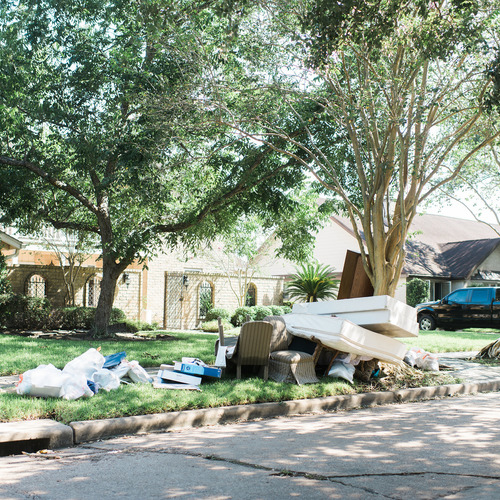
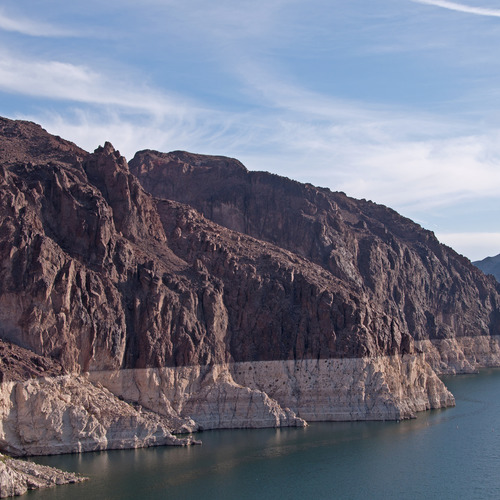
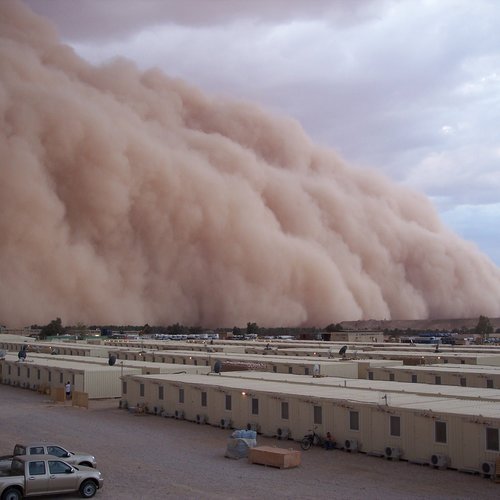
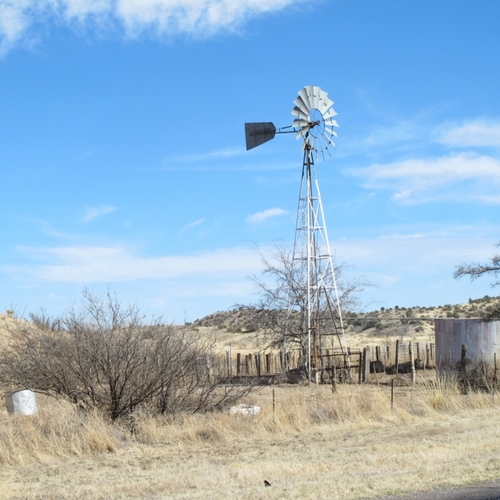






4 Comments
Welcome back
Looking forward to hearing more about where your physical and mental wanderings took you.
Yes,
Welcome back Alex.
The southern route
Alex,
I'm still impressed that you chose the "souther route". I'd guess that it certainly requires more "resilience" from a person than the northern routes.
On the southern route
I lived in the Southwest for a few years in the late 70s, and I wanted to see that part of the country from a different perspective. But there was also a practical reason to choose a southern route: timing. I wanted to do the trip at the beginning of my sabbatical, starting in late March. I had to be pretty far south to get over the Rockies at that time of year. Even as far south as I was, I ran into some cold weather in those mountain passes.
Log in or create an account to post a comment.
Sign up Log in